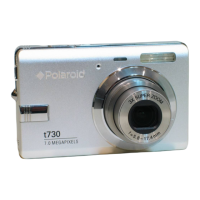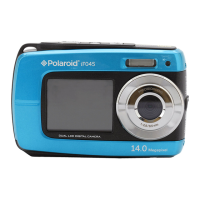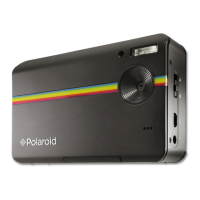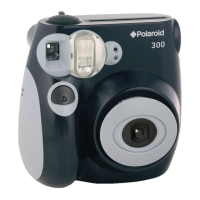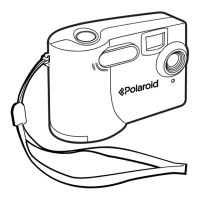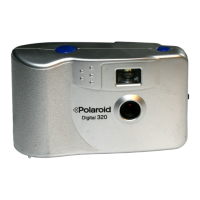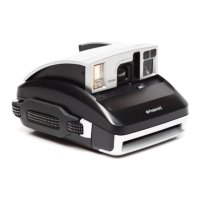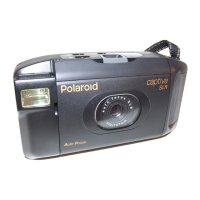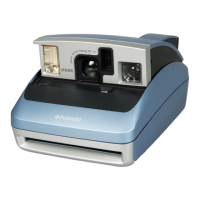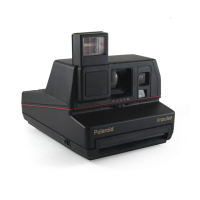Why images on the TV screen from my Polaroid X530 do not display in colour?
- YycardenasSep 9, 2025
If images on the TV screen aren't displaying in color, it could be due to a wrong system selection. Change to NTSC or PAL.
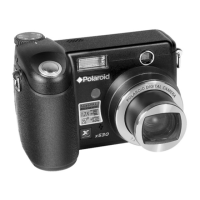
Why images on the TV screen from my Polaroid X530 do not display in colour?
If images on the TV screen aren't displaying in color, it could be due to a wrong system selection. Change to NTSC or PAL.
What to do if I cannot upload images from my Polaroid X530 Digital Camera to my computer?
If you're having trouble uploading images, it could be due to a connection failure or an issue with the camera driver. First, check that all cable connections are secure and that the card reader is properly plugged into the computer. If you're using a Windows 98SE system, ensure that you have installed the camera driver.
What to do if image is not recorded when the shutter button is pressed on my Polaroid Digital Camera?
If your camera isn't recording images when you press the shutter button, it could be due to several reasons. First, ensure that the camera is turned on. If the flash unit is charging, wait until it finishes. Also, check if the memory is full; if so, delete images you no longer need or use another memory card.
Why recorded pictures are not saved in memory on my Polaroid X530?
If your recorded pictures aren't being saved, it could be because the camera powered off before the save operation completed, or the memory card was removed prematurely. If the battery is exhausted, recharge it. Also, do not remove the memory card before the save operation is completed.
Why my Polaroid X530 cannot take pictures?
If the camera cannot take pictures, several factors could be the cause. The flash might be recharging, or the SD card might not be formatted correctly or damaged. The camera might be set to the . Or the SD card memory might be full. Wait until completing recharging the flash. If the SD card may be damaged, please use a new card. Set the camera in . Delete images you no longer need, or use another memory card.
Why does my Polaroid X530 Digital Camera suddenly power off?
Your camera might be powering off suddenly because the Auto Power Off function is activated, or the battery is exhausted. Try turning the camera back on. If that doesn't work, recharge the battery.
Why pictures are not displayed on my Polaroid X530 Digital Camera?
If pictures aren't being displayed, a memory card with non-DCF pictures recorded with another camera might be loaded in the camera. The camera cannot display non-DCF pictures recorded onto a memory card used by another digital camera.
Why ArcSoft PhotoStudio can not automatically detect or view the X3F flie from my Polaroid Digital Camera?
If ArcSoft PhotoStudio can't detect or view the X3F file, it's because ArcSoft PhotoStudio does not support the X3F file format. Use the Polaroid PhotoLab to convert the X3F file to the JPEG or TIFF format. Then ArcSoft PhotoStudio can open the file in JPEG or TIFF format.
Why the LCD screen does not appear on the screen of the connected television connected to my Polaroid Digital Camera?
If the LCD screen isn't appearing on the connected television, there might be a problem with the camera-TV connection, the TV setup might be wrong, or the video system might be incompatible. Use the supplied video cable to connect the camera to the TV. Consult the documentation of the TV and set it to video mode. Select the proper video output system.
What to do if my Polaroid X530 Digital Camera CD Installation Wizard does not work?
If the CD Installation Wizard isn't working, the auto installation file may be switched off, or the CD-ROM may be disconnected. Go to the computer desktop. Right click on “My Computer”. Click “Properties”. Select “Device Manager”. Double click on “CD- ROM”, double click on “CD-R (normally the manufacturer’s name), Click on “Settings”. Ensure both “Auto insert notifci ation” and the “disconnect” are ticked. If you change the settings the computer will ask you to restart your PC. Click “Yes.”
| Brand | Polaroid |
|---|---|
| Model | X530 |
| Category | Digital Camera |
| Language | English |
Lists all items included in the camera's packaging for initial setup.
Provides step-by-step instructions for attaching the camera's neck strap.
Details the procedure for inserting and removing the camera's battery.
Explains how to connect the AC adapter for power and charging.
Guides the user on how to charge the camera's rechargeable battery.
Covers the insertion, precautions, and formatting of SD cards for storage.
Describes the process of powering the digital camera on and off.
Explains how to check the current battery power level on the LCD screen.
Details how to view active camera settings and status icons on the LCD.
Explains the eight different modes for recording and playing pictures/videos.
Guides on using buttons to navigate menus and function bars for settings.
Shows how to access the main setup menu for customizing camera settings.
Instructions for setting the camera's date and time for accurate metadata.
Describes how to configure the camera's automatic power-saving shutdown.
Explains how to enable or disable beep sounds for button presses.
Details how to adjust the volume for beep sounds and video clips.
Guides on selecting the preferred language for the camera's menus.
Explains how to imprint the date on pictures for record-keeping.
Provides steps to adjust the brightness level of the LCD screen.
Instructions for resetting all camera settings to their factory defaults.
Explains how to control the assignment of sequential file numbers.
Guides on disabling the startup animation image when turning on the camera.
Describes how to change the information displayed on the LCD screen.
Explains how to use different scene modes for various shooting conditions.
Details how to take photos using the viewfinder instead of the LCD screen.
Guides on selecting different flash modes (Off, Auto, Red-eye, Forced On).
Explains how to use the 2-second or 10-second self-timer for delayed shots.
Describes how to capture multiple pictures in quick succession.
Explains how to use optical and digital zoom to frame subjects.
Guides on adjusting image resolution and JPEG compression settings.
Explains how to set the duration the picture is displayed after capture.
Details how to enable or disable the AF assist beam for low-light focusing.
Guides on choosing between automatic and manual focus modes.
Explains how to adjust exposure compensation (EV) for better lighting results.
Guides on adjusting the camera's sensitivity to light (ISO).
Explains how to adjust white balance for natural color reproduction.
Guides on applying color tones and moods to pictures (Vivid, Sepia, etc.).
Explains how to choose light metering methods (Multiple, Centre, Spot).
Provides instructions on how to record video clips with audio.
Guides on selecting video resolution (640x480, 320x240) for clip quality.
Explains how to adjust exposure compensation for video recording.
Guides on adjusting white balance for natural colors in video clips.
Instructions for viewing pictures in full screen or thumbnail mode.
Guides on how to view pictures and video clips in an automated slide show.
Explains how to rotate JPEG pictures by 90° clockwise for better viewing.
Details how to crop pictures to adjust size or location within the image.
Guides on applying color, contrast, or level enhancements to images.
Explains how to remove red-eye glare from subjects in images.
Instructions for playing recorded video clips.
Guides on how to protect files from accidental deletion.
Explains how to delete individual or all pictures and video clips.
Details how to connect the camera to a TV to view content.
Explains the Digital Print Order Format for printing settings.
Provides instructions for installing the camera software on different Windows versions.
Lists and describes the software applications provided on the CD-ROM.
Outlines the minimum hardware and OS requirements for Windows and Mac.
Important note for Windows 98SE users regarding driver installation before transfer.
Guides on inserting/removing SD cards and transferring files using a card reader.
Explains how to connect the camera to a computer using a USB cable.
Details the process of transferring files using a USB cable connection.
A guide to common problems and their solutions for camera operation.
Provides the website for online support and FAQs.
Offers contact details for assistance with the card reader.
Lists contact information for technical support of ArcSoft software.
Detailed technical specifications of the camera, including resolution and features.
Provides charts showing approximate picture/video capacity on different SD card sizes.
Instructions for removing the camera driver from Windows 98SE systems.
Guides on removing the USB storage driver from Windows systems.
Lists the default settings for various camera modes and functions.
Tips for maximizing battery life and important warnings regarding battery use.
Provides advice on safe operation, environmental conditions, and camera care.
Contains FCC notices and compliance information for the device.
